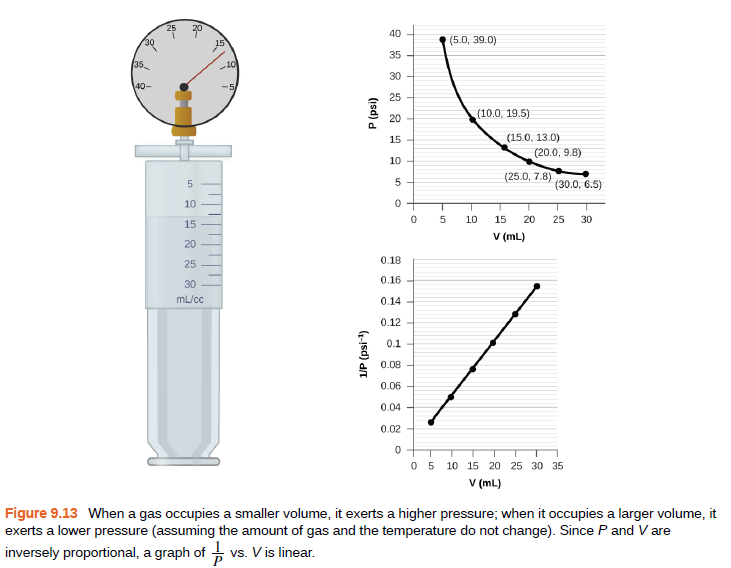25 30 30 40 (5.0, 39.0) 35 35 -10 30 40- 25 - (10.0, 19.5) 20 - 15 - (15.0, 13.0) (20.0, 9.8) 10 (25.0, 7.8) (30.0, 6.5) 10 T 10 15 20 25 30 15 v (mL) 20 0.18 25 0.16 30 mL/cc 0.14 0.12 0.1 - 0.08 0.06 0.04 - 0.02 0 5 10 15 20 25 30 35 V (mL) Figure 9.13 When a gas occupies a smaller volume, it exerts a higher pressure; when it occupies a larger volume, it exerts a lower pressure (assuming the amount of gas and the temperature do not change). Since P and V are inversely proportional, a graph of - vs. V is linear. 1/P (psi) P(psi)
25 30 30 40 (5.0, 39.0) 35 35 -10 30 40- 25 - (10.0, 19.5) 20 - 15 - (15.0, 13.0) (20.0, 9.8) 10 (25.0, 7.8) (30.0, 6.5) 10 T 10 15 20 25 30 15 v (mL) 20 0.18 25 0.16 30 mL/cc 0.14 0.12 0.1 - 0.08 0.06 0.04 - 0.02 0 5 10 15 20 25 30 35 V (mL) Figure 9.13 When a gas occupies a smaller volume, it exerts a higher pressure; when it occupies a larger volume, it exerts a lower pressure (assuming the amount of gas and the temperature do not change). Since P and V are inversely proportional, a graph of - vs. V is linear. 1/P (psi) P(psi)
Chapter7: Statistical Data Treatment And Evaluation
Section: Chapter Questions
Problem 7.16QAP
Related questions
Question
The sample of gas as shown has a volume of 15.0 mL at a pressure of 13.0 psi. Determine the pressure of the gas at a volume of 7.5 mL, using:
(a) the P-V graph as shown.
(b) the (1P) vs. V graph as shown.
(c) the Boyle’s law equation Comment on the likely accuracy of each method.

Transcribed Image Text:25 30
30
40
(5.0, 39.0)
35
35
-10
30
40-
25 -
(10.0, 19.5)
20 -
15 -
(15.0, 13.0)
(20.0, 9.8)
10
(25.0, 7.8)
(30.0, 6.5)
10
T
10
15
20
25
30
15
v (mL)
20
0.18
25
0.16
30
mL/cc
0.14
0.12
0.1 -
0.08
0.06
0.04 -
0.02
0 5 10 15 20 25 30 35
V (mL)
Figure 9.13 When a gas occupies a smaller volume, it exerts a higher pressure; when it occupies a larger volume, it
exerts a lower pressure (assuming the amount of gas and the temperature do not change). Since P and V are
inversely proportional, a graph of - vs. V is linear.
1/P (psi)
P(psi)
Expert Solution
This question has been solved!
Explore an expertly crafted, step-by-step solution for a thorough understanding of key concepts.
This is a popular solution!
Trending now
This is a popular solution!
Step by step
Solved in 3 steps with 1 images

Knowledge Booster
Learn more about
Need a deep-dive on the concept behind this application? Look no further. Learn more about this topic, chemistry and related others by exploring similar questions and additional content below.Recommended textbooks for you



Chemistry
Chemistry
ISBN:
9781305957404
Author:
Steven S. Zumdahl, Susan A. Zumdahl, Donald J. DeCoste
Publisher:
Cengage Learning



Chemistry
Chemistry
ISBN:
9781305957404
Author:
Steven S. Zumdahl, Susan A. Zumdahl, Donald J. DeCoste
Publisher:
Cengage Learning

Chemistry: An Atoms First Approach
Chemistry
ISBN:
9781305079243
Author:
Steven S. Zumdahl, Susan A. Zumdahl
Publisher:
Cengage Learning
